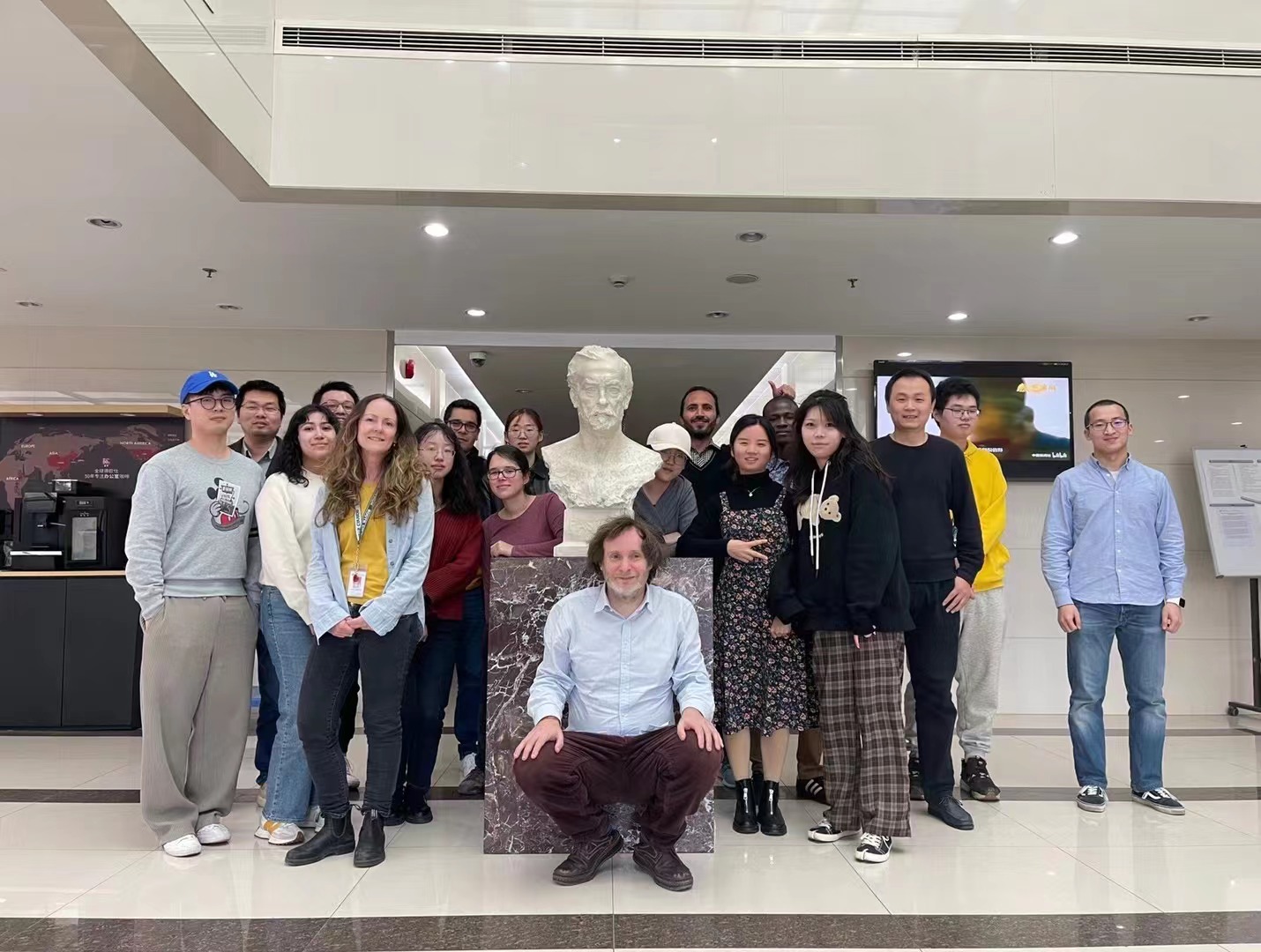
Daniel FALUSHPh.D.
- Academic title:Principal Investigator
- Discipline:Evolutionary biology
- Departments:Statistical Genetics of Bacteria
- Phone:86-182 1726 7529
- E-mail:Daniel.falush@siii.cas.cn
- Mailing Address:B401, Life Science Research Building, 320 Yueyang Road, Xuhui District, Shanghai 200031, P.R. China
Academic Experience
2019-present Principle Investigator,
2014-2019 MRC Senior Research Fellow
05-07.2014 Project Professor, University of Tokyo
2010-2014 Senior Scientist, Max Planck Institute for Evolutionary Anthropology, Leipzig
2008-2010 Senior Research Fellow, Department of Microbiology, University College Cork
2003-2007 Wellcome Trust Career Development Fellow, Department of Statistics, University of Oxford
2000-2003 Postdoc, Max Planck Institute for Infection Biology, Berlin
1998-2000 Japan Society for the Promotion of Science Fellow, Department of Mathematical Biology, Kyushu University
Education
BA, Cambridge, Mathematics.
PhD University College London, Genetics
I have developed and applied statistical genetic tools to understand diverse biological processes in bacteria, humans and other organisms.
Current research interests include:
1. Helicobacter pylori evolution.
2. Fitness landscapes in natural bacterial populations.
3. Comparative population genetics of bacterial species.
4. Community dynamics from metagenomics data.
Research highlights during my career include:
The most powerful method to extract ancestry information from DNA sequence data (chromosome painting/fine STRUCTURE, refs 5,7 and 8 below).
The first bacterial genome wide association study (ref 6 below).
The first bacterial genome wide epistasis scan (ref 9).
The first hidden markov model in population genetics (the linkage model of STRUCTURE, ref 1).
The first method to infer bacterial evolution incorporating recombination and mutation (ClonalFrame, ref 4)
The research group currently focuses on four themes:
Helicobacter pylori – life on the edge of chaos.
H. pylori is an important member of the human microbiota for several reasons, including its role in gastric cancer and its well-studied interaction with the human immune system during chronic infection. It also accumulates and reassorts genetic variation at an exceptionally high rate. We are assembling thousands of genome from across the world, including high and low disease incidence regions in China in order to understand its evolution from multiple perspectives and to make the organism a model system for population genetics.
Epistasis and fitness landscapes in natural bacterial populations.
Bacteria face a wide diversity of challenges in the natural environment, many of which are difficult to study in the laboratory. We are developing tools to reveal fitness interactions between loci and the diversity of strategies used by bacteria in the same species. There is a particular focus on highly recombining species, including Vibrio parahaemolyticus and H. pylori that recombine at high rates, which give the richest epistasis signals.
Comparative genomics of bacteria
For the first time, we have genome date from of 1000s of strains from 100s of different bacterial species. We are building an evolutionarily annotated database in order to understand how evolutionary and ecological factors combine to determine the pattern of diversity in different species.
Community composition dynamics from metagenomics data
The microbiota of the human digestive tract is a diverse, important and increasingly well-studied community. But the rules governing community composition and its evolution over time are far from being understood. Together with other research groups from the Centre for Microbes Development and Health http://www.shanghaipasteur.cas.cn/CMDH, we will investigate how different species interact with each other and their host.
Selected publications
(12) A tutorial on how (not) to over-interpret STRUCTURE/ADMIXTURE barplots. Nature Communications 2018 9, 3258. Lawson D, van Dorp L, Falush D.
(11) The Landscape of Realized Homologous Recombination in Pathogenic Bacteria.
Molecular Biology and Evolution 2016 33 456-71.
Yahara K, Didelot X, Jolley KA, Kobayashi I, Maiden MCJ, Sheppard SK, Falush D.
(10) Rapid evolution of distinct Helicobacter pylori subpopulations in the Americas.
PLOS Genetics 2017 13 e1006730
Thorell K, Yahara K, Berthenet E, Lawson DJ, Mikhail J, Kato I, Mendez A, Rizzato C, Bravo MM, Suzuki R, Yamaoka Y, Torres J, Sheppard SK, Falush D.
(9) Epidemic clones, oceanic gene pools and eco-LD in the free living marine pathogen Vibrio parahaemolyticus.
Molecular Biology and Evolution 2015 32 1396-1410.
Cui Y, Yang X, Didelot X, Guo C, Li D, Yan Y, Zhang Y, Yuan Y, Yang H, Wang J, Wang J, Song Y,Zhou D, Falush D*, R Yang*
(8) The fine-scale genetic structure of the British population.
Nature 2015 519, 309-314.
Leslie, S, Winney, B, Hellenthal, G, Davison, D, Boumertit, A, Day, T, Hutnik, K, Royrvik, EC, Cunliffe, B, Lawson, DJ, Falush, D, Freeman C, Pirinen M, Myers S, Robinson M, Donnelly P, Bodmer, W.
(7) A genetic atlas of human admixture history.
Science 2014 343 747-751.
Hellenthal G, Busby GBJ, Band G, Wilson JF, Capelli C, Falush D*, Myers S*.
(6) Genome-wide association study identifies vitamin B5 biosynthesis as a host specificity factor in Campylobacter. PNAS 2013 110 11923-11927.
Sheppard S, Didelot X, Meric G, Torralbo A, Jolley KA, Kelley DJ, Bentley SD, Maiden MCJ, Parkhill J, Falush D.
(5) Inference of population structure using dense haplotype data.
PLoS Genetics 2012 8 e1002453.
Lawson DJ, Hellenthal G, Myers S*, Falush D*.
(4) Inference of bacterial microevolution using multilocus sequence data.
Genetics 2007 175 1251-1266.
Didelot X, Falush D.
(3) Mismatch induced speciation in Salmonella: model and data.
Philosophical Transactions of the Royal Society B 2006 361 2045-2053.
Falush D, Torpdahl M, Didelot X, Wilson DJ, Conrad D, Achtman M.
(2) Traces of human migrations in Helicobacter pylori populations.
Science 2003 299 1582-1585.
Falush D, Wirth T, Linz B, Pritchard JK, Stephens M, Kidd M, Blaser MJ, Graham DY, Vacher S, Perez-Perez GI, Yamaoka Y, Megraud F, Otto K, Reichard U, Katzowitsch E, Wang X, Achtman M, Suerbaum S.
(1) Inference of population structure using multilocus genotype data: linked loci and
correlated allele frequencies. Genetics 2003 164 1567-1587. Falush D, Stephens M JK Pritchard.


